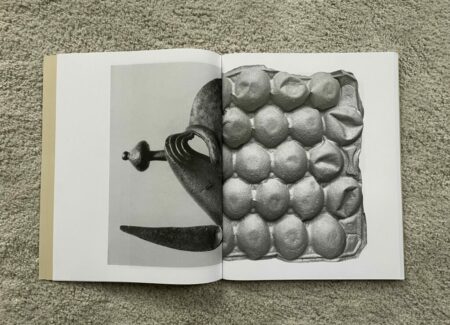JTF (just the facts): Co-published by Roma Publications (publisher site here, book link here) and Keijiban (book link here) in 2023. Softcover, 25 x32 cm, 136 pages, with black-and-white and color reproductions. Design by Roger Willems and the artist. (Cover and spread shots below.)
Comments/Context: Protective packaging materials are the kind of non-thing that we typically pay little direct attention to in the bustle of our 21st century lives. We open our boxes and packages, discard the packing, and quickly get right at whatever is inside, leaving the wrappings strewn on the floor until they are picked up and summarily thrown away. The intermediate bubble wrap, packing peanuts, cardboard casings, inflated airbags, and other protections have effectively served their purpose, and now seemingly have no additional function.
Batia Suter’s photobook Exosphere takes as its main subject these packing materials, paying unexpectedly close attention to their sculptural qualities. Her deadpan photographs place these objects against blank white backgrounds, highlighting the design attributes of packing for what might be fruit, vegetables, headphones, and likely other less identifiable products; her precise photographic approach makes the scale of the packing trays difficult to gauge, offering up possibilities ranging from tiny pharmaceutical blister packs to much larger and heavier materials in molded cardboard rounds and squares.
That Suter would discover visual interest in these overlooked materials and proceed to systematically explore their properties in depth is perhaps not entirely unexpected, given her artistic history. For the past decade, the Swiss-born, Amsterdam-based artist has been creating taxonomies, typologies, and arrangements of visual patterns built from images scavenged from a dizzying variety of found materials, including her own photographs. Her excellent 2018 photobook Radial Grammar (reviewed here) explored the structural language of an eclectic range of circular and geometrically balanced forms, and her 2019 gallery show “Cloud Service” (reviewed here) followed that up with an inspired dive into cloud motifs and their analogues. Her artistic eye seems rooted in making links, connections, and echoes, and teasing out patterns from diverse visual data sets.
Exosphere mixes Suter’s images of packing materials with a dozen or more archival images of ancient armor, like helmets and sandals; there are even a pair of images of scuba swim fins, which take the idea of packaging/protection in yet another direction. Suter has harmonized all these images and printed them in black-and-white on two sided sheets, with each item generally given the full width of the spread. These sheets have then been gathered and hemmed at the middle with a saddle stitch to create the book. The effect is somewhat unexpected in that aside for the image at the very center of the book, each object is cut in half and reshuffled by the binding technique. This creates page turns and spreads that are two unmatched halves, which of course activates and amplifies Suter’s ideas of recombination and association.
Like Erin Shirreff’s elegantly matched art historical book plates, Suter’s Exosphere feels like a repeated exercise in sculptural pairing, where two unrelated images come together to form a hybrid visual statement. In a way, this treatment abstracts our initial sense of function or purpose, leaving behind the reality of packaging designed to protect one thing or another and allowing the essential beauty of the forms to come forward. And who would have expected that these protective systems could be so gorgeous? Suter shows us sumptuous teardrop curves, crackled and puckered surfaces, repeated grids, intricately arranged groupings like molecules or honeycombs, soft undulations like sand dunes or waves, and rounded shapes like textural snowballs waiting to be thrown. These surfaces are then spilt and recombined with unlike partners, endlessly remixing the visual themes and associations across time.
There is an elemental simplicity and legibility to Exosphere that makes its subtle lessons approachable. Each page turn feels like a rediscovery, and each pairing highlights unlikely contrasts and parallels. In this way, Suter’s artistic vision stands out as singular and unique, her ability to see the essential structure of an object transformed into an agile vehicle for expansive formal experimentation.
Collector’s POV: Batia Suter does not appear to have consistent gallery representation at this time. As a result, interested collectors should likely follow up directly with the artist via her website (linked in the sidebar).
























